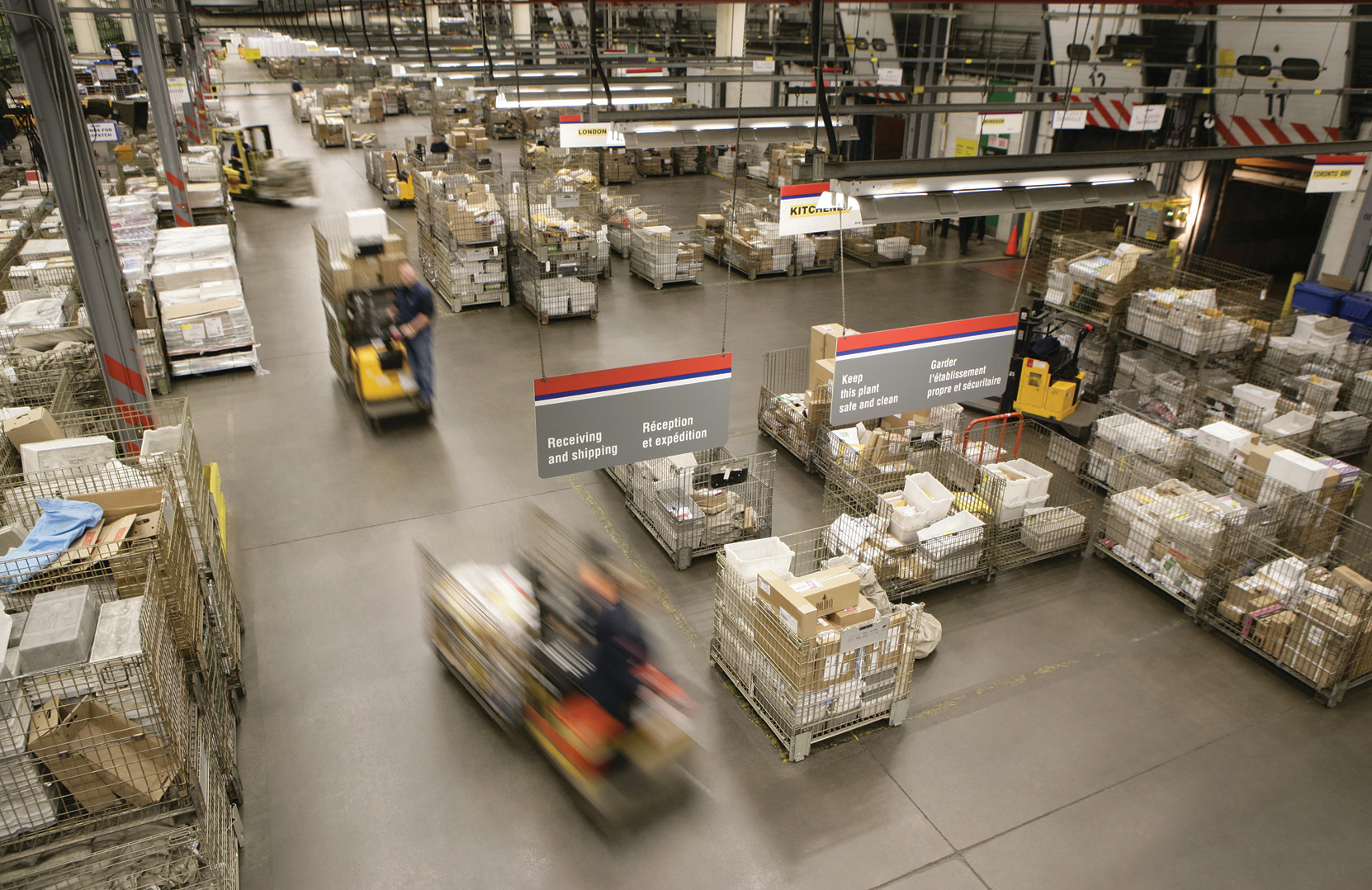Since April, almost every one of James Ball’s work days has ended later than he’s used to. On its own, this wouldn’t be a major problem for him, except for the fact that his customers are not used to it either.
“When it reaches the point that people are answering their doors in their nighties, they tend not to like it, even if you are bringing them a package,” Ball says with a laugh.
As a letter carrier for Canada Post, Ball and his coworkers have been bearing the brunt of a massive surge in parcel deliveries. Between February and May, when the COVID-19 pandemic arrived in Canada, online sales surged by 99.3 per cent, reaching a record-breaking $3.9 billion spent online in May, according to a report from Statistics Canada. This is alongside a correspondingly record-breaking decline in retail sales, which plunged 10 per cent nationally in March alone according to the report — the largest monthly decline on record and more than double the previous record of 4.5 per cent in February 1998, says the report. Retail and online sales went up as stores reopened to a limited capacity later in the spring, but only slightly.
This, of course, means that the volume of parcels being shipped has surged to record-breaking levels as well. According to Canada Post, the volume of parcels has increased by 35.4 per cent, or 26 million units, in the second quarter, over the same period in 2019. In a press release, the company said the volumes were “as high as in past peak Christmas seasons.”
“These Christmas volumes basically started right when the pandemic started, they just shot up,” says Roland Schmidt, president of the Edmonton local of the Canadian Union of Postal Workers, “and they’ve just been at this constant full-throttle mode since then.”
Increases in the amount of mail do not always mean more work for mail carriers, but Ball says the specifics of how people are shopping in the pandemic have most of the staff working weekends and overtime. Some of these shifts, like his, are at irregular times, since the shifts have been staggered to help avoid crowding in Canada Post’s facilities.
“If you order one parcel or you order two, I still come to your door once,” says Ball. “Now, it’s customers who have never ordered parcels before are now ordering parcels, and they’re ordering one at a time. I’ve had more than a few people say ‘Oh, I didn’t think that was going to arrive so fast, I’ve never ordered online before.’”
Schmidt, whose union represents around 2,300 workers locally, and almost 50,000 nationally, says that the postal workers he interacts with generally welcome the holiday rush, since it is expected and the overtime hours help cover their own giftbuying. However, this surge has been continuous since February, with no end immediately in sight, and it has been taking its toll.
“When that holiday period is extended to, say, six months, you have workers taking on considerably more weight and volume, which also contributes to more fatigue-related injuries or even slips trips and falls. The more people are working and the more weight that is applied to it just statistically, that will lead to more injuries,” says Schmidt.
“The routes are getting longer, and they are getting harder, and we are looking at a very high injury rate” agrees Ball. “I walk 20 kilometres a day, and I drive a third of my route. There are others who hardly drive their route at all.”
Besides injuries, there is also the virus itself to worry about. For the most part, Schmidt says that Canada Post has been doing relatively well at ensuring the safety of its employees, after a slow start and pressure from the union and its members. Back in March, he spoke to CBC about how the company was lacking personal protective equipment and social distancing measures in both the Edmonton delivery depots and processing hub.
“When the pandemic hit, they were lacking in leadership as far as identifying problems and implementing safety protocol,” Schmidt says. The union formulated a list of demands, he adds, and after a month or so of no response, employees threatened to refuse to work. Canada Post swiftly implemented proper safety measures soon after that, he says, and since then, employees at these facilities have felt safe, in spite of a few reported infections.
“The logic was always that it’s inevitable that people will bring the infection from outside into the workplace, but we want to set it up so that it mitigates any internal transmission. Since (the safety measure were implemented) there has not been any contamination spread inside the facility, like it has happened in Winnipeg or places in Ontario,” he says, referring to outbreaks at a Winnipeg processing plant on Nov. 8, a Hamilton depot on Oct. 21, and an Etobicoke depot on Sept. 22.
However, company policy is only responsible for so much. While those working inside the facilities appear relatively safe, for delivery drivers like Ball, there is always a risk of exposure, since their job demands they interface with people and businesses, and enter many different public areas. Ball recalls a number of close encounters inside apartment buildings where residents wander by the mailboxes on their way to the laundry room, not wearing personal protective equipment since they understandably feel as though they are in their homes despite it being a common area, or on business pickups where a solitary warehouse worker not be wearing a mask offers to help him load his truck, and others.
“The whole thing makes you make some weird decisions, like how you open the door to the convenience store you’re delivering to. You take a second look at everything you do,” he says. “I am used to helping elderly customers, for example, bringing their parcels just inside their door. Now I can’t really do that.”
“I basically have direct interactions with a lot of people every day. I’m trying to limit that, but it’s difficult.”
This means mail carriers are not just subject to the health and safety policies of every place they walk into, not just Canada Post’s. Schmidt is particularly concerned about the strategy of the Alberta government, which he says is poor, mainly due to the lack of enforcement of social distancing and sanitation measures, the fact that a number of high-risk businesses such as restaurants, bars, and gyms, have been allowed to stay open, and that primary schools opened for in-person classes for the fall semester, even as COVID-19 cases are spiking.
“They’re trying to have their cake and eat it too, by pretending that things could be business as usual. In the meantime, the virus is getting out of control, and it really undermines our efforts in the workplace to protect our members — people are just getting sick at a higher level in Alberta overall,” he says.
The number of cases in Alberta has been rising rapidly since September. Data from the Public Health Agency of Canada shows the province is averaging just over 900 cases per day and has a total of 13,166 active cases as of Nov. 23, the highest per capita of any province in Canada, with the Edmonton zone making up the bulk of them. This trend is showing no signs of slowing down either — the province’s record for new daily cases was set on Nov. 23, at 1,549. Edmonton’s Mayor, Don Iveson, also asked the province for stricter rules in a statement to the press issued on Nov. 19. Alberta is the only province that does not impose mandatory masks in public, as of Nov. 20.
Ball too is concerned about the provincial government’s handling of the pandemic, and says he encounters unsafe situa tions created by the lack of restrictions regularly.
“I deliver to four schools. I’ve arranged to have them meet me either outside the front door or put it in a mailbox, and that has helped, but still, sometimes I’ll go to the front door and the kids will all be outside on their break, and they’re not wearing masks, because it’s break time” he says. And, of course, the fact that mail carriers are busier than ever only heightens how exposed they are.
“If I have to deliver, say, 30 per cent more parcels, that means 30 per cent more work, 30 per cent more stops, 30 per cent more interactions,” says Ball.
Even though Canada Post has been working with Christmas-like volumes of deliveries for six months, actual Christmas still brought its own expected surge on top.
“A survey conducted for Canada Post in June showed 48 per cent of Canadian shoppers plan on spending mostly or exclusively online this coming holiday,” said a spokesperson for the crown corporation prior to the holiday season. In an Oct. 21 statement to the public, Canada Post’s chief customer and marketing officer, Rod Hart, said the company was gearing up for a “holiday season like no other.”
Overall, this is a good thing, since retail environments are responsible for a significant portion of the virus’s spread. In Montreal, for example, the majority of outbreaks occurred in retail stores. But, the rush also means the concerns of workers are only going to get worse.
Schmidt says that since the early stages of the holiday rush began in the middle of November, and that Canada Post has been able to keep employees as safe as they can from the virus, introducing even more staggered shifts and expanding hours to accommodate the 4,000 seasonal employees the company hired. However, the issues of fatigue and other safety concerns are still around, and the measures the company has introduced may not be enough to offset them.
“On Christmas, we’re expected to work weekends — we’ve already been working weekends. We’re expected to work overtime — we’ve already been working overtime,” says Ball.
As the circumstances of the pandemic continue (and probably get worse) in Alberta, the postal service is going to continue being instrumental in allowing people to stay home and out of retail stores. The concern is that, without Canada Post scaling up their operations to meet the new demand for parcels, postal workers are more and more in danger of burning out and getting injured. This also means the postal service is going to be less able to fulfil this demand.
“If I can’t get all my deliveries done on one day, that’s just going to keep piling up onto the next day and the next day and the next day,” says Ball. “I’m concerned the customer is not going to get the service they want or that they should get.”
The one thing Ball does know is that he is going to be working late nights for the next little while, and asks the public to “expect we’re going to be out a little later than normal, and maybe keep their lights on.”
Image courtesy of Canada Post.





0 Comments